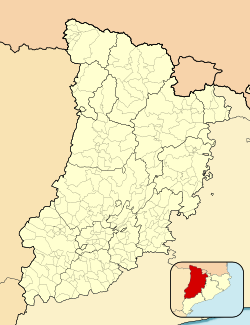The La Pedrera de Rúbies Formation, also called as La Pedrera de Meià[1][2] is an Early Cretaceous (late Berriasian to early Barremian geologic formation in Catalonia, Spain. The formation crops out in the area of the Montsec in the Organyà Basin. At the La Pedrera de Meià locality, the formation consists of rhythmically laminated, lithographic limestones that formed in the distal areas of a large, shallow coastal lake.[3] It is noted for the exceptional preservation of articulated small vertebrates and insects, similar to that of the Solnhofen Limestone.
| La Pedrera de Rúbies Formation | |
|---|---|
| Stratigraphic range: Late Berriasian-early Barremian ~ | |
 Exposure of the La Pedrera de Rúbies Formation at La Pedrera de Meià | |
| Type | Geological formation |
| Unit of | Montsec Group |
| Underlies | Prada Formation |
| Area | Montsec |
| Lithology | |
| Primary | Limestone |
| Location | |
| Coordinates | 42°00′N 0°54′E / 42.0°N 0.9°E |
| Approximate paleocoordinates | 31°18′N 11°18′E / 31.3°N 11.3°E |
| Region | Lérida Province, Catalonia |
| Country | |
| Extent | Pre-Pyrenees |
Fossil content
editThe La Pedrera de Rúbies Formation has yielded the enantiornithine bird Noguerornis and the scincogekkomorph lizard Pedrerasaurus,[4][5][6][7] and two species of Teiid lizard Meyasaurus, M. fauri and M. crusafonti, the indeterminate avialan Ilerdopteryx,[8] frogs Neusibatrachus wilferti,[9] and Montsechobatrachus. A crocodyliform Montsecosuchus and many insects and other arthropods, as:[10]
- Angarosphex lithographicu
- Archisphex catalunicus
- Artitocoblatta hispanica
- Chalicoridulum montsecensis
- Chrysobothris ballae
- Cionocoleus longicapitis
- Condalia woottoni
- Cretephialtites pedrerae
- Hirmoneura (Eohirmoneura) neli
- Hirmoneura richterae
- Iberoraphidia dividua
- Ilerdocossus pulcherrima
- Ilerdosphex wenzae
- Jarzembowskia edmundi
- Leridatoma pulcherrima
- Manlaya lacabrua
- Meiagaster cretaceus
- Meiatermes bertrani
- Mesoblattina colominasi
- Mesopalingea lerida
- Mimamontsecia cretacea
- Montsecbelus solutus
- Nanoraphidia lithographica
- Nogueroblatta fontllongae
- N. nana
- Pachypsyche vidali
- Pompilopterus montsecensis
- Proraphidia gomezi
- Prosyntexis montsecensis
- Pseudochrysobothris ballae
- Ptiolinites almuthae
- Vitisma occidentalis
- Cretaholocompsa montsecana
- Montsecosphex jarzembowskii
- Cretobestiola hispanica
- Angarosphex penyalveri
- Cretoserphus gomezi
- Bolbonectus lithographicus
- ?Anaglyphites pluricavus
- Palaeaeschna vidali
- Hispanochlorogomphus rossi
- Palaeouloborus lacasae
- Ichthyemidion vivaldi
Correlation
edit
See also
editReferences
edit- ^ Gil-Delgado, Alejandro; Delclòs, Xavier; Sellés, Albert; Galobart, Àngel; Oms, Oriol (2023-04-17). "The Early Cretaceous coastal lake Konservat-Lagerstätte of La Pedrera de Meià (Southern Pyrenees)". Geologica Acta. 21: 1–XIII. doi:10.1344/GeologicaActa2023.21.3. hdl:2445/201820. ISSN 1696-5728.
- ^ Galobart, Àngel; Párraga, Javier; Gil-Delgado, Alejandro (2022-02-25). "The Spread of Fossil heritage: How to Valorise the Lithographic Limestones of the La Pedrera de Meià and La Cabroa Quarries in the Orígens Unesco Global Geopark (Southern Pyrenees, Catalonia)". Geoheritage. 14 (1). doi:10.1007/s12371-022-00669-w. ISSN 1867-2477.
- ^ "La Pedrera de Meià". Paleobiology Database.
- ^ Weishampel et al., 2004, pp. 517-607
- ^ Lacasa Ruiz, 1989
- ^ Chiappé & Lacasa Ruiz, 2002
- ^ Bolet & Evans, 2010
- ^ Kellner, 2002
- ^ Báez & Sanchiz, 2007, p.477
- ^ La Pedrera de Rúbies Formation at Fossilworks.org
Bibliography
edit- Bolet, A.; Evans, S.E. (2010), "A new lizard from the Early Cretaceous of Catalonia (Spain), and the Mesozoic lizards of the Iberian Peninsula", Cretaceous Research, 31 (4): 447–457, doi:10.1016/j.cretres.2010.06.002
- Báez, A.M.; Sanchiz, B. (2007), "A review of Neusibatrachus wilferti, an Early Cretaceous frog from the Montsec Range, northeastern Spain", Acta Palaeontologica Polonica, 52: 477–487, retrieved 2019-10-09
- Weishampel, David B.; Dodson, Peter; Osmólska, Halszka (2004), The Dinosauria, 2nd edition, Berkeley: University of California Press, pp. 1–880, ISBN 0-520-24209-2, retrieved 2019-02-21
- Chiappé, L.; Lacasa Ruiz, A. (2002), Noguerornis gonzalezi (Aves: Ornithothoraces) from the Early Cretaceous of Spain in Chiappe and Witmer, (eds.). Mesozoic Birds: Above the Heads of Dinosaurs, University of California Press, pp. 230–239
- Kellner, A (2002), A review of avian Mesozoic fossil feathers in Chiappé and Witmer, (eds.). Mesozoic Birds: Above the Heads of Dinosaurs, University of California Press, pp. 389–404
- Lacasa Ruiz, A (1989), "New genus of fossil bird from the Neocomian locality of Montsec (Lerida province, Spain)", Estudios Geológicos, 45: 417–425
Further reading
edit- A. P. Rasnitsyn and J. Ansorge. 2000. Two new Lower Cretaceous hymenopterous insects (Insecta: Hymenoptera) from Sierra del Montsec, Spain. Acta Geológica Hispánica 35:59-64
- X. Martínez-Delclòs. 1993. Blátidos (Insecta, Blattodea) del Cretácico Inferior de España. Familias Mesoblattinidae, Blattulidae y Poliphagidae. Boletín Geológico y Minero 104:516-538
- X. Martínez-Delclòs. 1990. Insectos del Cretácico inferior de Santa Maria de Meià (Lleida): colleción Lluís Marià Vidal i Carreras. Treballs del Museu de Geologia de Barcelona 1:91-116
- P. E. S. Whalley and E. A. Jarzembowski. 1985. Fossil insects from the Lithographic Limestone Montsech (Late Jurassic-early Cretaceous), Lérida Province, Spain. Bulletin of the British Museum of Natural History (Geology) 38(5):381-412
- J. E. Gomez Pallerola. 1979. Un ave y otras especies fósiles nuevas de la biofacies de Santa María de Meyá (Lérida). Boletín Geológico y Minero 90:333-346

